The Hennepin County Master Gardener’s annual tour may be cancelled this year due to COVID-19, but that doesn’t mean these gardeners don’t still have tips and tricks to offer. Three local gardeners open up their yards and their hearts. And don’t worry. Their gardens will be open next year instead.
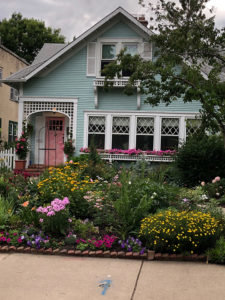 Sandra Mangel's cottage-style garden stops walkers in their tracks with its color and beauty. (Photo by Jan Willms)
Sandra Mangel's cottage-style garden stops walkers in their tracks with its color and beauty. (Photo by Jan Willms)Sandra Mangel loves color, and she feels color expresses the joy and love she has for life. The interior designer not only fills her home with color, but lets it flow through her gardens.
“My love for gardening and beauty came at an early age,” Mangel said. As a child, her father was in the war and when she was one year old she and her mom moved to California to be with her grandparents. “My grandmother had exquisite taste, and every day she had fresh flowers on the table.” Mangel’s mother was also a gardener who grew annuals, peonies, shrubs, roses and mock orange. Her mother-in-law was born on a farm and taught her about soil.
So with all this gardening background in her life, Mangel started gardening right away when she and her husband bought their home in south Minneapolis 48 years ago.
“I started with a rose garden in the back yard, because it was the only sunny spot we had,” she said. “I didn’t really think of gardening in the front yard, because that wasn’t the style then. I started gardening in the front yard about 30 years ago. The trees in the back yard had grown too tall and too lush for the rose beds.”
Her front bank garden has grown to incorporate the entire front yard sculpted within two small grassy areas. “I utilized my interior design skills to draft the initial plan to scale locating the perennials and shrubs. The annuals are sprinkled in each year for cutting and continuous color,”
 Sandra Mangel enjoys beauty indoors and out. She applies her interior design skills to planning for continuous color. (Photo by Jan Willms)
Sandra Mangel enjoys beauty indoors and out. She applies her interior design skills to planning for continuous color. (Photo by Jan Willms)Mangel explained.
She has taken out all the sod in the back yard and put in pavement to create a courtyard.
Mangel said she loves roses, lilies and phlox. “Phlox are blooming in the garden for a long time; they are lovely and lush and come in a whole variety of different colors. They are very hardy, and give a garden that fullness I desire.”
She said roses are the most challenging to grow, particularly with Japanese beetles and black spot attacking them. “I try to find something organic to combat those issues,” she said. “The only thing you can do with the beetles is pick them off.”
 Sandra Mangel's cottage-style garden stops walkers in their tracks with its color and beauty. (Photo by Jan Willms)
Sandra Mangel's cottage-style garden stops walkers in their tracks with its color and beauty. (Photo by Jan Willms)Day lilies are the easiest flower to grow, according to Mangel. “They are profuse and multiply like crazy. I have a whole bank of day lilies and hosta and white lamium. I keep dividing them, and last year took took all the lilies out and put in all pastels.”
Mangel said one of her rarest plants is a variegated Japanese pagoda in her backyard, a shrub that flowers lightly in the spring. “It grows very sparse and looks very Japanese. As it grows it has a lot of space in between. This is its third year. I found it in a nursery up north. When I take road trips, if I see a sign for a nursery I am definitely pulling in.”
Mangel said she has wanted to become a master gardener for a number of years and became one last year. “It’s extremely rewarding,” she said. “I help in community gardens and farmer’s markets, educating the public and making sure that people know who we are, and there is help available for problems and questions involving insects and plant diseases. We offer tips on what to plant for a rain garden or prairie garden or bird and butterfly garden.”
so you’re surprised around the bend
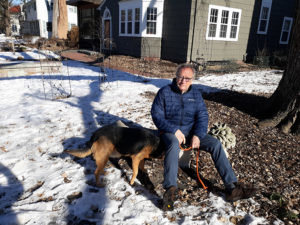 Steve Miles enjoys his gardens year-round, designing when he isn't planting or weeding. Since retiring, he's had time to make major upgrades. (Photo by Jan Willms)
Steve Miles enjoys his gardens year-round, designing when he isn't planting or weeding. Since retiring, he's had time to make major upgrades. (Photo by Jan Willms)Steve Miles, who lives on Riverside Parkway, started gardening when he was about 30. “There was a spirea hedge that was ugly, and it smelled. So I removed it,” he said. “I asked a landscape guy how to garden. He came over and laid out the first garden with hoses.” Miles said he started laying out more gardens with hoses. “The nice thing about that is that you get the scale right. You lay the hoses down on the ground, and it’s no commitment. You just get to think about it.”
He added, “My first garden was in the sun, with perennials. The next two were in the shade, and I planted ferns and hostas. I learned how to do woodland plants by trial and error.”
Miles has gradually added gardens over the years. He now has a kitchen garden, in which he installed raised beds in 2018. “With the high beds and wide aisles, I can work it as I age,” he said. His front garden is Asian in style, and the kitchen garden in back is western in form, linear and geometric in keeping with its functional purpose. He put in a bioswale rain garden along the boulevard.
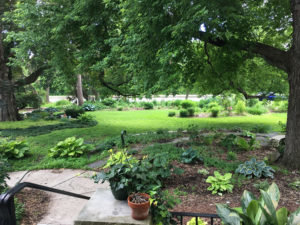 Hostas star in Steve Miles' shade gardens. (Photo submitted)
Hostas star in Steve Miles' shade gardens. (Photo submitted)“Originally I just stole the time to work in the gardens afternoons and evenings,” said Miles, a retired physician. “After I retired I made some more major upgrades. You do it in pieces.” He ordered 16 tons of stone and laid them in place instead of going to the gym.
“I put in a postman’s path, a cool thing from England,” he said. “You create a path so the postman can come straight across from the neighbor’s yard. You can incorporate it into the garden.”
Miles said he “lives out there” in his gardens. “It’s very peaceful; I put in benches for where I want to rest while I’m weeding.”
“The whole garden is designed for pollinators. One of the things that surprised me, the more bees I worked with, I never got stung.”
Miles said he chooses to use no herbicides or pesticides at all. He cut down on roses after a Japanese beetle plague some years ago, but he said there is a soil bacteria called milky spore that you can lay down in the garden, and it kills the larva of the beetles.
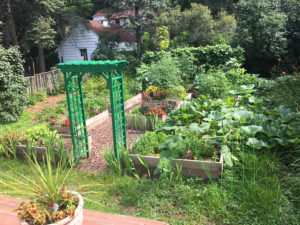 Miles added a kitchen garden with raised beds in 2018 so that he can work on it as he ages. (Photo submitted)
Miles added a kitchen garden with raised beds in 2018 so that he can work on it as he ages. (Photo submitted)“The lawn itself is a garden,” Miles said. “I’ve got creeping charley, dandelions, squill, violets and forget-me-nots. I did not plan it that way, but that is critical for the bees. You have to let your lawn go native. If you spray it, you’re starving or killing the bees, so I don’t do any of that.”
Miles seeks diversity in his garden, which has many little microenvironments. He said that using curve shapes in a garden is so cool because it forces you to take bendy walks. “When you do that, the perspective is always shifting. Some days I take a walk and see an arrangement of plants that I had no idea I had set up, and it’s lovely.”
Miles said he works on gardening all year, designing when he isn’t planting or weeding. As a master gardener, he serves on an arboretum e-line, answering questions about lemon trees or philodendrons or how to clean up property.
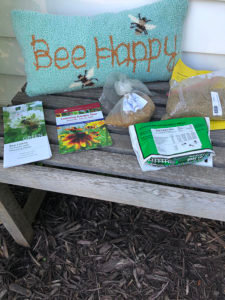 Views of Melinda Ludwiczak's gardens highlight her use of color year-round. Learn more about becoming a master gardener at hennepinmastergardeners.org. (Photos submitted)
Views of Melinda Ludwiczak's gardens highlight her use of color year-round. Learn more about becoming a master gardener at hennepinmastergardeners.org. (Photos submitted)When Melinda Ludwiczak moved to Minneapolis in 1992 and worked as a community coordinator for Robbinsdale Schools, she started attending some classes taught by a master gardener. Twenty years ago, she became a master gardener herself.
“I have been inspired by what we learn,” she said. “A few years ago at one of our conferences, we had Thomas Friedman, a landscape architect, talk about how we need to look at our landscape as a plant community. You look at how things grow in nature, and how they grow in layers. He said we use too much mulch in our gardens in America. We are master gardeners, not master mulchers. Okay, I get that. So I try to understory things with plants, and I don’t use a lot of mulch.”
Ludwiczak said her garden is a work in progress. “You’re never finished. I decided to work with a landscaper to install some paths and stone.” She removed a buckthorn hedge that went all the way around the perimeter of her yard to the front. “I was inspired by one of my neighbors who had a lot of plants around the edge, and I liked that, so I started putting in a lot of plants.”
In the last few years, recognizing the pollinator crisis, especially with bees, Ludwiczak took a special training so that as a master gardener she could talk with the public about how to create more pollinator habitats. “I decided to really dig in to that,” she quipped. “So my garden is more of a pollinator design than a landscape design; it’s a mix of trees, shrubs, flowers, perennials and annuals. We kind of know what the pollinators like and why.” She created a pollinator habitat, with plants blooming from late April until October.
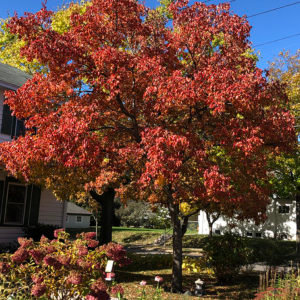 Views of Melinda Ludwiczak's gardens highlight her use of color year-round. Learn more about becoming a master gardener at hennepinmastergardeners.org. (Photos submitted)
Views of Melinda Ludwiczak's gardens highlight her use of color year-round. Learn more about becoming a master gardener at hennepinmastergardeners.org. (Photos submitted)“You want different heights, different colors and different petal shapes,” Ludwiczak explained. She said you have to give pollinators an opportunity to get into the flower to get the pollen.
She noted that butterflies are not pollinators, but they are in peril and need to survive. Flies are more abundant pollinators than any insect, but they are not in danger. Bees are. “We have several thousand different bees in the U.S. I think Minnesota has over 400 native bees,” she said.
At the last legislative session, legislators appropriated nearly a million dollars to enhance and create pollinator habitats in Minnesota. “They are offering homeowners reimbursement for pollinator habitat in their landscape,” Ludwiczak said. “There were 6,000 applicants this first go-round.”
She grows low-mow or no-mow grass, which provides a lawn that only needs to be mowed once or twice a season. “The grass doesn’t go to seed; it thickens up and grows taller and lays over,” Ludwiczak said. “My granddaughter calls it Dr. Seuss grass.”
She said more cities are changing ordinances so that people can install that kind of grass. People can learn how to do away with so much turf that doesn’t provide much nutrition to pollinators and other critters. They can plant more shrubs that are beneficial.
“I have seen more and more front yards that are just plants, in the city and suburbs, too.”
Hydrangea is Ludwiczak’s favorite plant. “It comes in so many colors and shapes,” she said. “And I am really proud of my lavender. There are only a couple varieties that survive our winters here, and I have had one for a long time in a sunny spot.”
For Ludwiczak, her biggest gardening struggle is with a rabbit and keeping it from eating everything. “He has eaten all the raspberries I have. I used to have a lot of shrubbery, and the rabbits ate them down to the ground. I gave up on them,” she commented.
“I also find growing plants in the shade challenging,” she continued. “We have shade over our deck, and trying to find plants that aren’t all hostas and have some color has been hard.”
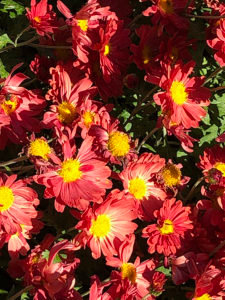 Views of Melinda Ludwiczak's gardens highlight her use of color year-round. Learn more about becoming a master gardener at hennepinmastergardeners.org. (Photos submitted)
Views of Melinda Ludwiczak's gardens highlight her use of color year-round. Learn more about becoming a master gardener at hennepinmastergardeners.org. (Photos submitted)Her most unusual plant is a holly she has in the front of her house, one of the first things she got. “I don’t know what kind it is; I bought it when I was really new at this.”
Ludwiczak said she keeps busy as a master gardener, doing a lot of community education and helping plan the annual conference held each year. “The big trend this year is houseplants,” she said. “A lot of younger gardeners see it as internal decorating, if you don’t have a lot of room.”
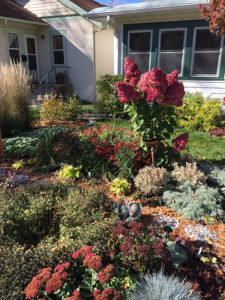 Views of Melinda Ludwiczak's gardens highlight her use of color year-round. Learn more about becoming a master gardener at hennepinmastergardeners.org. (Photos submitted)
Views of Melinda Ludwiczak's gardens highlight her use of color year-round. Learn more about becoming a master gardener at hennepinmastergardeners.org. (Photos submitted)
Comments
No comments on this item Please log in to comment by clicking here